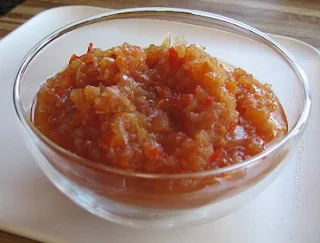Mauritian Chutney: A History and Classic Mango Recipe
Mauritian Chutney: The Soulful Condiment of the Indian Ocean
For the culinary explorer, the food of the Indian Ocean is a siren song of spice routes and cultural fusion. Nowhere is this more evident than in Mauritius, a volcanic island where African, European, and Asian flavors have collided to create one of the world's most dynamic cuisines. And at the heart of every Mauritian meal, you'll find its vibrant soul: chutney.
Forget what you know about the preserved chutneys in jars. Mauritian chutney (or chatini) is a fresh, often daily-made condiment that is the very essence of the island's "gout" or taste. It's a living history lesson—a taste of India, reborn with the tropical bounty of the Indian Ocean.
From Indian Staples to Island Innovations: A Culinary Migration
The Roots: Indentured Labor and Culinary Memory
In the 19th century, Indian indentured laborers arrived on Mauritian shores, carrying little but their culinary heritage. They brought with them the fundamental techniques for making chutney—a method of pounding fresh herbs, spices, and souring agents into a pungent relish.
But a new land demanded new ingredients. The classic Indian coriander (cilantro) and mint chutneys were soon transformed by the island's incredible produce. This wasn't mere substitution; it was a creative explosion.
The Mauritian Pantry: A Chutney Maker's Paradise
What truly defines Mauritian chutney is its use of unique local ingredients. Indian spices met tropical fruits and herbs, creating entirely new flavor profiles:
- Green Mango: Used unripe for a tart, bracing chutney that cuts through rich curries.
- Bilimbi (Blimbling): This intensely sour, green fruit is a classic base, offering a sharpness lime can't match.
- Pomme Cythere (Golden Apple): Both ripe and green versions are used for a sweet-and-sour relish.
- Pandan Leaf: Blended into chutneys for a subtle, sweet, and floral aroma that is uniquely Mauritian.
- Local Chilis: From the mild to the fiery piment rouge, these provide the essential heat.
A Chutney for Every Bite: The Essential Guide
In Mauritius, no meal is complete without a selection of chutneys. Each one is chosen to complement specific dishes, creating a harmonious balance on the plate.
Must-Try Mauritian Chutneys
- Coriander Chutney (Chatini Coton): The undisputed king. Fresh cilantro, mint, green chili, garlic, and lime are pounded into a vibrant, herbaceous paste. Perfect with: Dholl Puri, grilled fish, and rice.
- Tomato Chutney: A cooked, savory-sweet relish with onions, garlic, and thyme. Perfect with: Stews, lentils (daube), and roasted meats.
- Mango Chutney (Chatini Mangue): Unlike its Western counterpart, the Mauritian version is often fresh, tart, and spicy when made with green mango. Perfect with: Fried snacks like gato pima (chili fritters) and curries.
- Chili Chutney (Piment Ecrasé): A simple but powerful condiment of crushed chilies, oil, and vinegar. It's on every table, like salt and pepper. Perfect with: Absolutely everything.
Bringing Mauritius to Your Kitchen: An Authentic Mango Chutney Recipe
This recipe is for a cooked, preserved-style chutney, a wonderful way to capture the taste of the island. It's fantastic with cheese, cold meats, or as a side to a curry night.
Authentic Mauritian-Style Mango Chutney
Yields: 2-3 jars
Ingredients:
- 4 cups ripe but firm mangoes, peeled and chopped
- 1 ½ cups white vinegar
- 1 ½ cups brown sugar
- 1 cup golden raisins
- 1 large onion, finely chopped
- 3 cloves garlic, minced
- 1 tbsp fresh ginger, grated
- 1 tsp cumin seeds
- 1 tsp chili flakes (adjust to taste)
- ½ tsp cinnamon
- ½ tsp allspice
- Salt to taste
Directions:
- In a large, non-reactive pot, combine the mangoes, vinegar, sugar, raisins, onion, garlic, and ginger.
- Bring to a simmer over medium heat, stirring until the sugar dissolves.
- Add the cumin seeds, chili flakes, cinnamon, allspice, and a pinch of salt.
- Reduce the heat to low and simmer gently for 45-60 minutes, stirring occasionally to prevent sticking, until the mixture has thickened and the mango is soft.
- To test if it's ready, draw a spoon across the bottom of the pot; the channel should hold for a second before filling in.
- While hot, carefully pour the chutney into clean, sterilized jars. Seal tightly.
- Allow to cool completely before storing. The flavors will meld and improve after a few days.
More Than a Condiment: A Taste of Connection
To taste a Mauritian chutney is to understand the soul of the island. It's a story of resilience, adaptation, and joyful creativity. It’s the taste of history, shared from one food-loving culture to another. So, the next time you're exploring the cuisines of the world, start with a spoonful of chatini—it might just be the most flavorful history lesson you'll ever have.










